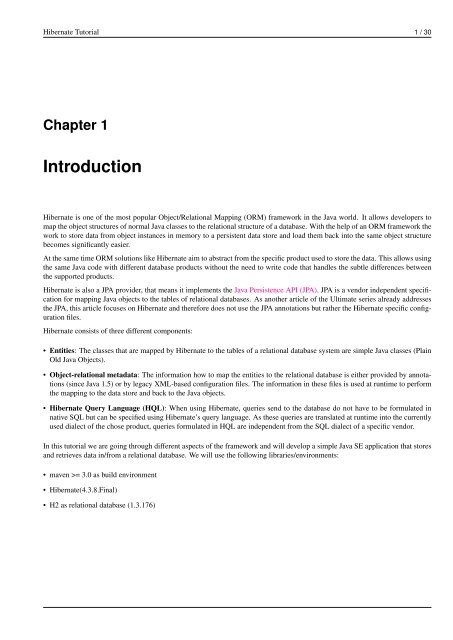Hibernate-Tutorial
Create successful ePaper yourself
Turn your PDF publications into a flip-book with our unique Google optimized e-Paper software.
<strong>Hibernate</strong> <strong>Tutorial</strong> 1 / 30<br />
Chapter 1<br />
Introduction<br />
<strong>Hibernate</strong> is one of the most popular Object/Relational Mapping (ORM) framework in the Java world. It allows developers to<br />
map the object structures of normal Java classes to the relational structure of a database. With the help of an ORM framework the<br />
work to store data from object instances in memory to a persistent data store and load them back into the same object structure<br />
becomes significantly easier.<br />
At the same time ORM solutions like <strong>Hibernate</strong> aim to abstract from the specific product used to store the data. This allows using<br />
the same Java code with different database products without the need to write code that handles the subtle differences between<br />
the supported products.<br />
<strong>Hibernate</strong> is also a JPA provider, that means it implements the Java Persistence API (JPA). JPA is a vendor independent specification<br />
for mapping Java objects to the tables of relational databases. As another article of the Ultimate series already addresses<br />
the JPA, this article focuses on <strong>Hibernate</strong> and therefore does not use the JPA annotations but rather the <strong>Hibernate</strong> specific configuration<br />
files.<br />
<strong>Hibernate</strong> consists of three different components:<br />
• Entities: The classes that are mapped by <strong>Hibernate</strong> to the tables of a relational database system are simple Java classes (Plain<br />
Old Java Objects).<br />
• Object-relational metadata: The information how to map the entities to the relational database is either provided by annotations<br />
(since Java 1.5) or by legacy XML-based configuration files. The information in these files is used at runtime to perform<br />
the mapping to the data store and back to the Java objects.<br />
• <strong>Hibernate</strong> Query Language (HQL): When using <strong>Hibernate</strong>, queries send to the database do not have to be formulated in<br />
native SQL but can be specified using <strong>Hibernate</strong>’s query language. As these queries are translated at runtime into the currently<br />
used dialect of the chose product, queries formulated in HQL are independent from the SQL dialect of a specific vendor.<br />
In this tutorial we are going through different aspects of the framework and will develop a simple Java SE application that stores<br />
and retrieves data in/from a relational database. We will use the following libraries/environments:<br />
• maven >= 3.0 as build environment<br />
• <strong>Hibernate</strong>(4.3.8.Final)<br />
• H2 as relational database (1.3.176)


